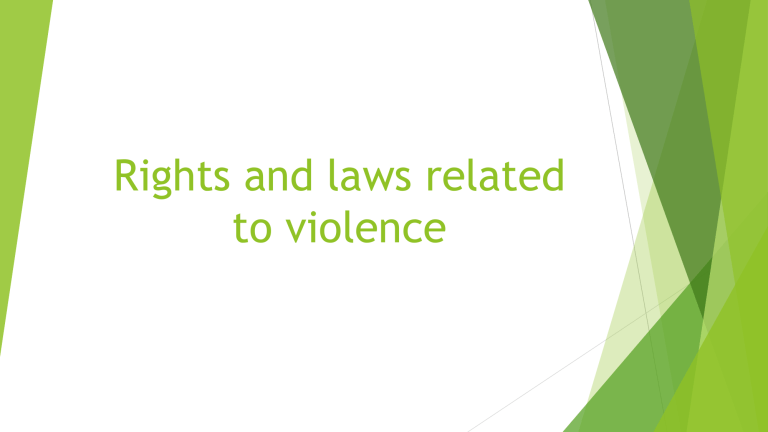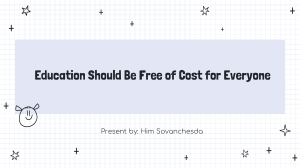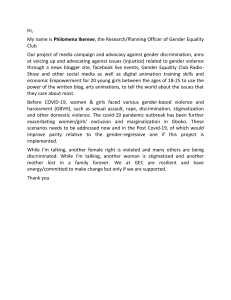
Rights and laws related to violence Statistic about Violance According to the Palestinian Centre for Human Rights' (PCHR) statistics in 2022, 6 women have been killed in the West Bank; 2 of them due to the misuse of firearms, while 3 women were killed in the Gaza Strip: one in a family dispute, the other by one of her family members and the third due to the misuse of firearms. Why Violance against women is an important issue ? Violence against women and girls is a human rights violation, and the immediate and long-term physical, sexual, and mental consequences for women and girls can be devastating, including death. Violence negatively affects women's general well-being and prevents women from fully participating in society. Violence can negatively affect women's physical, mental, sexual, and reproductive health. It is associated with increased risk of injuries, depression, anxiety disorders, unplanned pregnancies, sexually transmitted infections, HIV and many other health problems The Universal Declaration of Human Rights االعالن العالمي لحقوق االنسان Article 1. All human beings are born free and equal in dignity and rights. الشرط االول Article 2. Everyone is entitled يستحق to all the rights and freedoms set forth المنصوص عليهاin this Declaration, without distinction of any kind, such as race, colour, sex, language, religion, political or other opinion, national or social origin, property, birth or other status. Article 3. Everyone has the right to life, libertyالحريه of person. and security Article 4. No one shall be subjected to torture يعذبor to cruel, inhuman or degrading treatment or punishment اليجوز اخضاع احد للتعذيب او العقاب Fourth World Conference on Women (1995): Platform for action The Fourth World Conference on Women: Action for Equality, Development and Peace was the name given for a conference convened by the United Nations during 4–15 September 1995 in Beijing, بكينChina. At this conference, governments from around the world agreed on a comprehensive plan to achieve global legal equality المساواه, known as the Beijing Platform for Action. منصة بكين للعمل على تحقيق المساواه الشامله القانونيه العالميه First World Conference on Women, Mexico City, 1975 Main article: World Conference on Women, 1975ز In conjunction with International Women's Year, the first world conference on women was held in Mexico City in 1975. It resulted in the Declaration of Mexico on the Equality المساواه والعدالهof Women and Their Contribution to Development and Peace. Second World Conference on Women, Copenhagen, 1980 Main article: World Conference on Women, 1980 The second world conference on women was held in Copenhagen in 1980. The conference agreed that the 1979 Convention on the Elimination of All Forms of Discrimination التخلص من كل اشكال التمييز ضد النساءوهو حجر اأساسagainst Women was an important milestone. The Copenhagen conference also acknowledged the gap between rights being secured for women and women's ability to exercise those rights. It was also agreed that it was action on the three areas of: تدريب النساء على كيفية الدفاع وكيفية تحصيل هذه الحقوق Equal access to education; Employment opportunities; and adequate health care services are essential to achieve the goals set out in Mexico. Third World Conference on Women, Nairobi, 1985 Main article: World Conference on Women, 1985 The third world conference on women was held in Nairobi in 1985. The Nairobi conference set out areas by which progress in women's equality could be measured: constitutional and legal measures; equality in social participation; equality in political participation; and decision-making. The conference also acknowledged that women need to participate in all areas of human activity, not just those areas that relate to gender. Preceding the Fourth World Conference on Women, Beijing بكين, 1995 Delegates had prepared the UNDP Beijing Express Declaration aimed at achieving greater equality and opportunity for women. Attendees . The conference was attended by representatives of 189 governments, UN agencies, intergovernmental organizations such as the European Union and League of Arab States, as well as activists and organizations from across the world. There were 17,000 participants, with a further 30,000 activists attending a parallel Forum المنتدى. The Beijing Platform for Action: The Beijing Declaration and Platform for Action is widely known as the most progressive blueprint for advancing women's rights. The framework covers 12 areas of concern: Fourth World Conference on Women (1995): Platform for action 112: Violence against women is an obstacle عقبةto the achievement of the objectives of equality, development and peace. العنف ضد المرأه يشكل عقبه في تحقيق المساواه والتطور واألمان للمراه Violence against women both violates and impairs or nullifies او يبطلthe enjoyment by women of their human rights and fundamental freedoms. يمنع 114: Other acts of violence against women include violation of the human rights of women in situations of armed conflict, in particular murder جريمة قتل, systematic rape, sexual slavery عبوديةand forced pregnancy قانون العقوبات األردني رقم 16لسنة1996 االيذاء المقصود الناجم عنه تعطيل اكثر من ( )20يوم كل من أقدم قصداً على ضرب شخص أو جرحه أو إيذائه بأي فعل مؤثر من وسائل العنف واالعتداء نجم عنه مرض أو تعطيل عن العمل مدة تزيد على عشرين يوماً ،عوقب بالحبس من ثالثة أشهر إلى ثالث سنوات. مشروع قانون العقوبات الفلسطيني 2 المادة 249باب الضرب والجرح الجسيم والبسيط واإليذاء الخفيف ً ونجم عن ذلك إصابة أو عجز عن األشغال الشخصية ً عمدا ”كل من ضرب أو جرح شخصا ً يعاقب بالحبس مدة ال تزيد على السنة“. Legal issues According the American Health Lawyers Association (2000) the health care professionals should satisfy several duties to their patient, including: Duty to evaluate, diagnose, and intervene appropriately to ensure the patient’s safety . Duty to implement and comply with policies and protocols for the appropriate management of domestic violence . Duty to appropriately intervene in order to ensure the safety of their patients. Ethical considerations Violence against women violates human rights, العنف ضد المرأه ينتهك حقوق االنسانhas a major impact on health and causes great suffering. Physical and sexual abuse is illegal; emotional abuse is unethical and robs people of their basic rights to dignity and individuality. Ethical principles that apply to VAW Violence against women include:الميدأ األخالقي الذي ينطبق على العنف ضد المرأه • Patient well being • Patient advocacy المناصره للمريض • Patient respect and dignity احترام المريض وكرامته • Patient safety • Patient self-determination تقرير المصير • Fairness • Non-malfeasance (non-infliction of harm) عدم االساءة • Beneficence ( production of benefit ) االحسان • Confidentiality and privacy Privacy Privacy is “the right and power to control the information (about oneself) that others possess” (WHO 2000b). Privacy also commonly refers to the privacy of a person and the rights of individuals not to be physically exposed against their will. • Visual privacy includes protection from unnecessary bodily exposure, which may occur during a physical examination. No one who is unnecessary to the procedure or examination should be allowed into the exam room without the explicit permission of the client. The client must agree to any compromise of her/his right to privacy. For example, to bring an observer in the room, the provider must comply with the client’s wishes. • Auditory privacy means that, to the extent possible, individual consultations should be conducted in private and nobody should hear what patient is saying , including family members Confidentiality السرية Confidentiality is “the duty of those who receive private information not to disclose it without the patient’s consent” (WHO 2000b). Confidentiality is the mechanism through which the client’s right to privacy is protected Breaches in Privacy and Confidentiality انتهاكات الخصوصية والسرية Examples of unintentional breaches: A staff member enters a room thinking it is empty while a partially dressed patient is being examined. Non-medical staff inadvertently overhears a conversation between medical staff consulting about a client’s condition. A client is observed in the waiting room of a clinic that provides sensitive health services (e.g. treatment of injury as a result of violence, abortion, etc.). Beneficence اإلحسان Beneficence is action that is done for the benefit of others. Beneficent actions can be taken to help prevent or remove harms or to simply improve the situation of others. Health care professionals do have an obligation to: 1) prevent and remove harms, and 2) weigh and balance possible benefits against possible risks of an action. Non-malfeasance means to “do no harm.” Health care professionals must refrain from providing ineffective treatments or acting with meanness toward patients Advocacy المناصرة Advocacy is a process which involves information-gathering, making the information accessible, discussing choices, facilitating decision-making by the individual and monitoring outcomes. The health care professionals have an important role in this process since it involves diagnosis, prognosis, treatment options, treatment decisions and treatment review. Health care professionals have a responsibility to protect the patient’s interests, even (where necessary) defending those interests against a perceived threat from other members of the team. Respect Respect : includes both autonomy and the respect for self-determination of those who are capable of deliberating about their personal goals, and protection of persons with impaired or diminished autonomy. Patient Self-Determination Patient Self-Determination rights include: 1. The right to make their own health care decisions 2. The right to accept or refuse medical treatment

